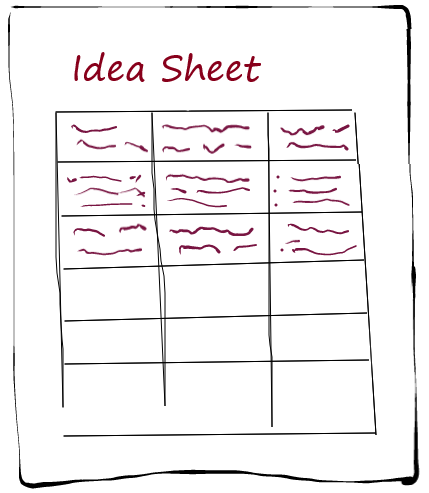# 6-3-5 Method
- Purpose
- To generate ideas in a group
- Time required
- 20 to 30 minutes
- Participants
- 1 moderator, 6 participants (UX team, user)
- Level of experience
- Beginner

# Summary
With the 6-3-5 method, a large number of ideas for solving a given problem can be created within a team of 6 people. The ideas are developed together: each participant gives first 3 proposals, which are extended by the others within 5 iterations.
# Result
The aim is to collectively develop as many ideas as possible for the given problem. The point is not the maturity of the ideas, but rather the quantity of the approaches and the integration of the whole group with the aim of discovering new creative ways to solve the problem.
# Approach
- Phrase the problem you are dealing with in a concise sentence on the whiteboard.
- Each participant receives a sheet of paper with an empty table (3 columns with 6 rows each).
- For the first line each participant writes down 3 ideas to solve the problem.
- After 3 minutes, the sheets are passed clockwise to the next person.
- Everyone now tries to develop the existing ideas and write down 3 new ideas.
- Steps 4 and 5 are run five times until all lines are filled.
- The group analyses, evaluates and discusses the results together.
# Time of use
The 6-3-5 method is useful when new and innovative problem-solving ideas are allowed and needed. For example, when old structures and methods are to be broken. It is expressly not necessary that the team is familiar with the problem area, because new and unusual ways of thinking can better help to solve the problem.
# Tools and Templates
- 6 Sheets with blank tables (3 columns with 6 rows each)
# Advantages
With the 6-3-5 method, many new ideas can be generated quickly in a structured manner and existing ones can be further developed. In addition, the creative potential of people who are more reserved in open group situations can be captured through individual work.
# Disadvantages
There is a risk that only known ideas will be taken up and documented. It is also necessary to revise the mostly superficial ideas.
# Hints
The results are produced within a short period of time and are therefore seldom mature or can even lead to nothing. In particular, they serve as a pointer for the further development of ideas.
# Sources
- Curedale: Design Thinking: process and methods manual (opens new window) Design Community College Inc. ISBN: 9780988236240.
- Die 6-3-5 Methode im Detail erklärt (German) (opens new window) Roland Padur.